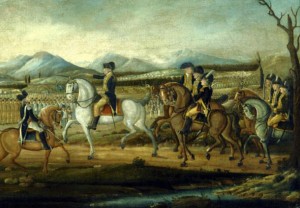
President George Washington, as Commander-in-Chief, leading a combined force of state militias against the Whiskey Rebellion in 1794.
Right-wing resistance to meaningful gun control is driven, in part, by a false notion that America's Founders adopted the Second Amendment because they wanted an armed population that could battle the U.S. government. The opposite is the truth, but many Americans seem to have embraced this absurd, anti-historical narrative.
The reality was that the Framers wrote the Constitution and added the Second Amendment with the goal of creating a strong central government with a citizens-based military force capable of putting down insurrections, not to enable or encourage uprisings. The key Framers, after all, were mostly men of means with a huge stake in an orderly society, the likes of George Washington and James Madison.
Daniel Shays, the leader of the revolt, was a former Continental Army captain who joined with other veterans and farmers to take up arms against the government for failing to address their economic grievances.
The rebellion alarmed retired Gen. George Washington who received reports on the developments from old Revolutionary War associates in Massachusetts, such as Gen. Henry Knox and Gen. Benjamin Lincoln. Washington was particularly concerned that the disorder might serve the interests of the British, who had only recently accepted the existence of the United States.
On Oct. 22, 1786, in a letter seeking more information from a friend in Connecticut, Washington wrote: "I am mortified beyond expression that in the moment of our acknowledged independence we should by our conduct verify the predictions of our transatlantic foe, and render ourselves ridiculous and contemptible in the eyes of all Europe."
In another letter on Nov. 7, 1786, Washington questioned Gen. Lincoln about the spreading unrest. "What is the cause of all these commotions? When and how will they end?" Lincoln responded: "Many of them appear to be absolutely so [mad] if an attempt to annihilate our present constitution and dissolve the present government can be considered as evidence of insanity."
However, the U.S. government lacked the means to restore order, so wealthy Bostonians financed their own force under Gen. Lincoln to crush the uprising in February 1787. Afterwards, Washington expressed satisfaction at the outcome but remained concerned the rebellion might be a sign that European predictions about American chaos were coming true.
"If three years ago [at the end of the American Revolution] any person had told me that at this day, I should see such a formidable rebellion against the laws & constitutions of our own making as now appears I should have thought him a bedlamite -- a fit subject for a mad house," Washington wrote to Knox on Feb. 3, 1787, adding that if the government "shrinks, or is unable to enforce its laws ... anarchy & confusion must prevail."
Washington's alarm about Shays' Rebellion was a key factor in his decision to take part in -- and preside over -- the Constitutional Convention, which was supposed to offer revisions to the Articles of Confederation but instead threw out the old structure entirely and replaced it with the U.S. Constitution, which shifted national sovereignty from the 13 states to "We the People" and dramatically enhanced the power of the central government.
The drastic changes prompted strong opposition from some Revolutionary War figures, such as Virginia's Patrick Henry, who denounced the federal power grab and rallied a movement known as the Anti-Federalists. Prospects for the Constitution's ratification were in such doubt that its principal architect James Madison joined in a sales campaign known as the Federalist Papers in which he tried to play down how radical his changes actually were.
To win over other skeptics, Madison agreed to support a Bill of Rights, which would be proposed as the first ten amendments to the Constitution. Madison's political maneuvering succeeded as the Constitution narrowly won approval in key states, such as Virginia, New York and Massachusetts. The First Congress then approved the Bill of Rights which were ratified in 1791. [For details, see Robert Parry's America's Stolen Narrative.]
Behind the Second Amendment
The Second Amendment dealt with concerns about "security" and the need for trained militias to ensure what the Constitution called "domestic Tranquility." There was also hesitancy among many Framers about the costs and risks from a large standing army, thus making militias composed of citizens an attractive alternative.
So, the Second Amendment read: "A well-regulated Militia, being necessary to the security of a free State, the right of the people to keep and bear Arms, shall not be infringed." Contrary to some current right-wing fantasies about the Framers wanting to encourage popular uprisings over grievances, the language of the amendment is clearly aimed at maintaining order within the country.
That point was driven home by the actions of the Second Congress amid another uprising which erupted in 1791 in western Pennsylvania. This anti-tax revolt, known as the Whiskey Rebellion, prompted Congress in 1792 to expand on the idea of "a well-regulated militia" by passing the Militia Acts which required all military-age white males to obtain their own muskets and equipment for service in militias.
In 1794, President Washington, who was determined to demonstrate the young government's resolve, led a combined force of state militias against the Whiskey rebels. Their revolt soon collapsed and order was restored, demonstrating how the Second Amendment helped serve the government in maintaining "security," as the Amendment says.
Beyond this clear historical record -- that the Framers' intent was to create security for the new Republic, not promote armed rebellions -- there is also the simple logic that the Framers represented the young nation's aristocracy. Many, like Washington, owned vast tracts of land. They recognized that a strong central government and domestic tranquility were in their economic interests.
(Note: You can view every article as one long page if you sign up as an Advocate Member, or higher).





